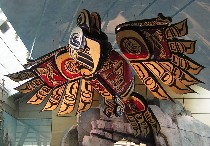
As soon as I stepped off the plane in Vancouver, I knew this was a different kind of city than Philadelphia. The airport had a sense of place, and some of what created the sense of place was the artwork. A giant wooden sculpture of a thunderbird, by Connie Watts, an artist with First Nations ancestry–First Nations being the Canadian p.c. term for the tribes living on the continent when the Europeans arrived–hung overhead (above). Watts named the piece after her grandmother, Hetux.
 The bird also hovered over a grouping of wooden sculptures arranged around a rocky water installation, which included a carved canoe, plus carvings of a number of water-related creatures like crabs and birds, and this seal by Stephen Bruce.
The bird also hovered over a grouping of wooden sculptures arranged around a rocky water installation, which included a carved canoe, plus carvings of a number of water-related creatures like crabs and birds, and this seal by Stephen Bruce.
Elsewhere in the airport, boldly colored weavings also let you know you were in the Northwest. And the building itself, with its glass and poles of metal suggesting icicles or shards of ice also gave a sense of place.
With such an auspicious beginning, I didn’t even bat an eye when we saw our friends Jane and George, who hail from California, while we were standing in one of the let-me-into-Canada lines at the airport.
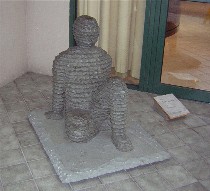 When we got to the hotel, we spotted sculptures outside along with our friends Susan and Steve, fellow Philadelphians (shown, Boaz Vaadia’s “Ginnetoy” on loan from a local gallery). Sculptures and wall art adorned the inside, too. The rooms also had art, my own having some beautifully colored lithographs by Bernard Cathelin–sweet still lifes of flowers–all on loan from the gallery.
When we got to the hotel, we spotted sculptures outside along with our friends Susan and Steve, fellow Philadelphians (shown, Boaz Vaadia’s “Ginnetoy” on loan from a local gallery). Sculptures and wall art adorned the inside, too. The rooms also had art, my own having some beautifully colored lithographs by Bernard Cathelin–sweet still lifes of flowers–all on loan from the gallery.
Art was a presence in any number of ways. There was beautiful craft glass used as architectural elements in a number of places we stopped, including casual restaurants and shops.
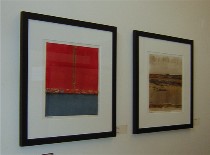 And in Granville, a warehouse district transformed into an arty area with galleries, studios, performance spaces, and of course shops and restaurants, I was filled with envy.
And in Granville, a warehouse district transformed into an arty area with galleries, studios, performance spaces, and of course shops and restaurants, I was filled with envy.
Why can’t Philadelphia pull off something like this? I wondered. (Shown, “Eastern Divide” and “Dusk in the Atacama Desert” by Tania Gleave in the Peter Kiss Gallery).
Signage
 So here’s an important difference between Vancouver and Philadelphia. In Philadelphia we have terrible signage and we constantly beat up on the city for its failure to do better (although it has improved somewhat). In Vancouver they have terrible signage, but they don’t seem to notice (shown, us lost in Stanley Park). They kept telling us how to get where we were going and assured us we couldn’t miss it. But miss it we did, over and over–the sidewalk, the aquarium, the bathrooms. They’re unrepentent about their bad signage.
So here’s an important difference between Vancouver and Philadelphia. In Philadelphia we have terrible signage and we constantly beat up on the city for its failure to do better (although it has improved somewhat). In Vancouver they have terrible signage, but they don’t seem to notice (shown, us lost in Stanley Park). They kept telling us how to get where we were going and assured us we couldn’t miss it. But miss it we did, over and over–the sidewalk, the aquarium, the bathrooms. They’re unrepentent about their bad signage.
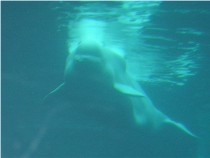 I won’t trouble you with a picture of the sidewalk or the bathrooms, but here’s a shot of a beluga whale at the aquarium.
I won’t trouble you with a picture of the sidewalk or the bathrooms, but here’s a shot of a beluga whale at the aquarium.
Alas, Vancouver had an “Orcas in the City” program, fiberglas orcas painted by local artists–an orca version of the mad cow disease that started in Chicago and became the mad dog disease of the Main Line.
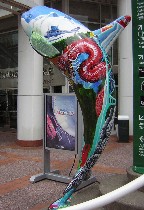
Here’s a sample from in front of the terminal where we caught our cruise ship, the Island Princess. This one was better than some of the others I saw, but this one, like the city, suffered from signage problems. I don’t know the artist or the name of the piece.
All on board
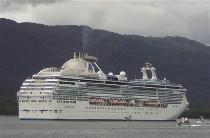 All of this was prelude to the object of the trip–Alaska aboard the Island Princess (shown near Ketchikan, Alaska), a 16-deck behomoth with 2,900 passengers and a crew of nearly 1,000.
All of this was prelude to the object of the trip–Alaska aboard the Island Princess (shown near Ketchikan, Alaska), a 16-deck behomoth with 2,900 passengers and a crew of nearly 1,000.
The first thing that greeted us as we headed toward our ship was a letter from the cruise line telling us that on the previous journey, a number of passengers were stricken with norovirus, the scourge of cruiseboats everywhere.
The crew maintained a frenzy of of disinfection, swabbing every inch of the boat throughout the cruise over and over. We also were required to swab our hands with disinfectant lotion (a la Purell) every time we entered the dining room. I’m happy to report our cruise was norovirus-free.
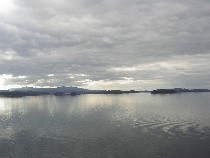 Even on that enormous ship, we felt like we were sailing up unexplored waters into the wilderness (shown, a view as we headed north toward Juneau).
Even on that enormous ship, we felt like we were sailing up unexplored waters into the wilderness (shown, a view as we headed north toward Juneau).
In the small city of Ketchikan, we had a share of nature–a sighting of about 60 to 80 bald eages, some soaring, some roosting, some hovering over the water and on the jetty at the mouth of the creek, probably in response to salmon collecting to begin their run upstream.
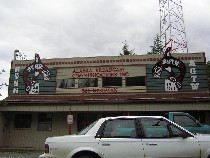 In no way can you forget that Alaska is all about salmon. The imagery in the art, the imagery in the signs, everywhere the stores selling the stuff, smoked and prepared in several ways. Here’s a sign from a Ketchikan radio station. I hope you can make out the salmon imagery. Must be Alaska.
In no way can you forget that Alaska is all about salmon. The imagery in the art, the imagery in the signs, everywhere the stores selling the stuff, smoked and prepared in several ways. Here’s a sign from a Ketchikan radio station. I hope you can make out the salmon imagery. Must be Alaska.
The totem poles also have salmon on them, not to mention ravens and whales and eagles and frogs, etc., etc.
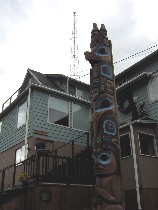 How about having a totem in your front yard? A Ketchikan resident commissioned this one and put it up in front of his house to honor his wife and her dead parents! Here’s some stuff I didn’t know about totem poles: they are not about religion, but rather tell stories about a clan, or a grudge, or sources of pride; they also serve as memorials; totems are fairly modern, going back to only the 19th century (that was a shock).
How about having a totem in your front yard? A Ketchikan resident commissioned this one and put it up in front of his house to honor his wife and her dead parents! Here’s some stuff I didn’t know about totem poles: they are not about religion, but rather tell stories about a clan, or a grudge, or sources of pride; they also serve as memorials; totems are fairly modern, going back to only the 19th century (that was a shock).
Return to nature
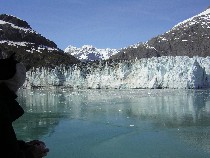 The highlights of the trip were the views of mountains and glaciers, so I’m writing this part of the post only so I can post a few pictures.
The highlights of the trip were the views of mountains and glaciers, so I’m writing this part of the post only so I can post a few pictures.
This one (above left) is the Marjorie Glacier in Glacier Bay (which is really not a bay but a fjord). The ice at the bottom cracked off the glacier, which calves chunks every 10 or 15 minutes.
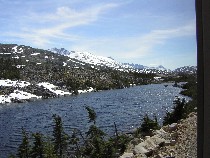 I thought I’d include this view on top of some rough, high terrain. The picture was taken from a little old gold-rush era train that took us through White Pass above Skagway.
I thought I’d include this view on top of some rough, high terrain. The picture was taken from a little old gold-rush era train that took us through White Pass above Skagway.
And I also wanted to mention that we saw humpback whales (or rather their flukes and signs of their presence like disturbed water and water blowing up from their blow holes), sea otters, stellar sea lions and porpoises.
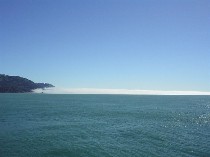 Here’s a view taken of retreating fog that disappeared more slowly than it appeared. One minute I looked up and there were mountains and glaciers. The next minute I looked up and there was nothing but fog–or mist as they prefered to say on board. We were on our way to College Fjord.
Here’s a view taken of retreating fog that disappeared more slowly than it appeared. One minute I looked up and there were mountains and glaciers. The next minute I looked up and there was nothing but fog–or mist as they prefered to say on board. We were on our way to College Fjord.
As for sunset, it was at 10 p.m. the last night on board. I’m not sure it ever got dark. Oh, and the weather was pretty warm–above 60, even 70. That was a suprise, too.









